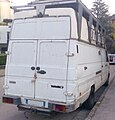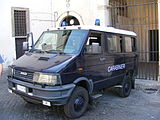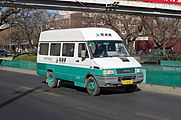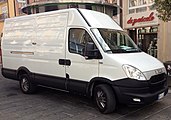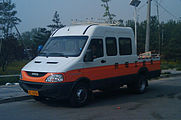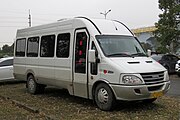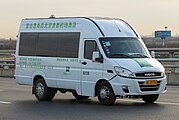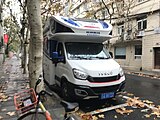auto.wikisort.org - Automobile
The Iveco Daily is a large light commercial van produced by the Italian automaker Iveco since 1978; it was also sold as the Fiat Daily by Fiat until 1983. Unlike the more car-like unibody Fiat Ducato, the Daily uses a separate ladder frame typical of heavier commercial vehicles. The Iveco Daily is produced at the Iveco Suzzara plant, near Mantova in Italy, where Iveco has recently[when?] made substantial investments to renew the production lines.
| Iveco Daily | |
|---|---|
 | |
| Overview | |
| Manufacturer | Iveco |
| Production | 1978–present |
| Body and chassis | |
| Class | Light commercial vehicle/Van (M) |
| Body style | Van Minibus Pickup truck |
| Layout | Front-engine, rear-wheel drive Front-engine, four-wheel drive |
| Chronology | |
| Predecessor |
|
| Successor | Fiat Ducato (for Fiat Daily and other first generation rebadges) |
The Daily is also the longest-running vehicle of the Iveco production and in over 40 years have sold over three million units. Today it is marketed in 110 markets around the world.[1]
First generation (1978)
Fiat Daily (1978)
| Fiat Daily | |
|---|---|
 Fiat Daily platform version | |
| Overview | |
| Manufacturer | Fiat |
| Also called | OM Grinta Alfa Romeo AR8 Unic Daily Magirus-Deutz Daily Saurer Daily/Grinta |
| Production | 1978–1985 |
| Assembly | Italy: Suzzara, Province of Mantua (Iveco SpA, Suzzara Plant) |
| Body and chassis | |
| Body style | Van Minibus Pickup truck |
| Powertrain | |
| Engine | Diesel: 4L Fiat 8140.61 |
| Transmission | 5-speed manual |
| Chronology | |
| Predecessor | Fiat 616 Fiat OM 40 Fiat 242 |
In 1978, Fiat presented a revolutionary vehicle called Daily. Light utility, succeeding the old Fiat 242 and Fiat 616, it immediately received a very favorable reception from users, who appreciated its excellent qualities of robustness and versatility. Its transformations for specific uses are numerous: panel van, chassis cab, double cab, etc.
When presented, the Daily was marketed as the Fiat Daily,[2] OM Grinta, and later the turbocharged version OM TurboGrinta,[3] and Alfa Romeo AR8 in Italy, Unic Daily in France, Magirus Daily in Germany, and in Switzerland, these were also sold by Saurer-Fiat and Saurer-OM as the Daily/Grinta,[4] with the small IVECO I logo at the bottom to the right of the grille, until 1982. Between 1982 and 1983, the IVECO logo prevails in the center of the grille, the Fiat or Unic brands being simply recalled at the bottom right.
When it was launched, the Daily range included 3 models: 30F8, 35F8 and 40F8. The first number represents the GVW of the vehicle expressed in Italian fashion, in quintals, i.e. 3.0, 3.5 and 4.0 tonnes. The "F" indicates FIAT, the engine manufacturer and the last digit corresponds to the engine power expressed in ten horsepower DIN.
Depending on its configuration, the useful volume of the long van version can reach 17 m3, which makes it a good successor to the Fiat 242 (Citroën C35 in France), whose production nevertheless continues.
In 1984, Fiat V.I., now IVECO, presented the Daily 4x4 range and, in 1985, launched the second Daily series, the TurboDaily.

Iveco TurboDaily (1985)
| Iveco TurboDaily | |
|---|---|
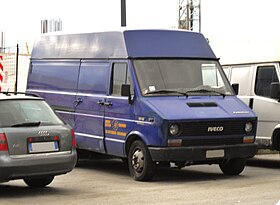 | |
| Overview | |
| Also called |
|
| Production | 1978–1999 1997–present (China) |
| Assembly | Italy: Suzzara, Province of Mantua (Iveco SpA, Suzzara Plant) Spain (after 1991): Valladolid (Iveco Espana, SL, Valladolid Plant) China (after 1986): Nanjing (Nanjing Iveco Automobile Co Ltd) Australia (after 1992): Dandenong South Serbia: Kragujevac Libya: Tajura (CKD) |
| Designer | Luan Hasnay |
| Body and chassis | |
| Body style | 4 door van 2-door chassis 4-door minibus |
| Layout | Front-engine, rear-wheel-drive Front-engine, four-wheel-drive |
| Powertrain | |
| Engine | Diesel: I4 2.5 I4 2.5 I4 2.5 turbo |
| Transmission | 5-speed manual |
| Dimensions | |
| Length | 6,150 mm (242.1 in) |
| Width | 2,000 mm (78.7 in) |
| Height | 2,770 mm (109.1 in) |
| Curb weight | 3,500–5,000 kg (7,716–11,023 lb) |
In 1985, Iveco presented the turbodiesel version, called TurboDaily.[5] To cover demand under 3.5 tonnes, reserved for the commercial vehicle division, Fiat Professional is also launching the Fiat Ducato.
Engines[6]
- 2.5 L diesel 72 hp (54 kW) at 4200 rpm, 141 N⋅m (104 lb⋅ft) at 2400 rpm
- 2.5 L turbodiesel 95 hp (71 kW) at 4100 rpm, 217 N⋅m (160 lb⋅ft) at 2300 rpm
- 2.5 L diesel I.D. 75 hp (56 kW) at 4200 rpm, 160 N⋅m (118 lb⋅ft) at 2200 rpm (only in Zastava Rival)
Facelift
- Iveco TurboDaily (front)
- Iveco TurboDaily (rear)
- Carabinieri Iveco Daily 4x4
The facelift of the first generation Daily was introduced in 1990, with a totally revised cab and improvements on the Sofim engine (at that time, with a 2.5 L capacity). Following the entry of Ford's commercial operation into Iveco, in 1986, The Daily 3.5 ton was soon removed from the UK market as it was now direct competition with Ford's Transit, the Daily stayed on in the UK at rated above 4.0 ton, and now sold as the Iveco-Ford Daily. The Daily has no other connection with the Transit. Turbodiesel versions are called "TurboDaily."
The facelift of the 1º generation was facelifted in 1996; it differs only slightly exterior-wise, but the engine was now available in 2.8-litre capacity 76 kW (102 hp). The 59-12 (chassis cabs and panel vans) and 59-13 (minibus) models were launched (GVW 6.4 tons). All-wheel-drive variants were also made available.
Engines
- 2.5 L diesel 75 hp (56 kW) at 4,200 rpm
- 2.5 L turbodiesel 103 hp (77 kW) at 3,800 rpm
- 2.5 L tdi 116 hp (87 kW) at 3,800 rpm
- 2.8 L diesel 85 hp (63 kW)
- 2.8 L turbodiesel 103 hp (77 kW) at 3,600 rpm
- 2.8 L tdi 122 hp (91 kW) at 3,600 rpm
Chinese production
Since 1997, the Daily has been license built in China by Nanjing Automobile subsidiary Naveco. The model was sold as the Deyi (得意), and later spawned modernized facelift variants called the Xindeyi (新得意, New Daily) in 2011 and 2017.[7][8]
- Naveco Deyi (Turbo Daily)
- Naveco Deyi (Turbo Daily) (rear)
- Crew cab
- Tow truck
Facelift
- Naveco Xindeyi (first facelift, front)
- Naveco Xindeyi (first facelift, rear)
- Naveco Xindeyi (second facelift, front)
- Naveco Xindeyi (second facelift, rear)
Second generation (1999)
| Second generation | |
|---|---|
 Second generation Daily as a minibus | |
| Overview | |
| Manufacturer | Iveco |
| Also called | Irisbus Daily Irisbus EcoDaily (2009–11) Iveco Daily Ousheng (China) |
| Production | 1999–2014 2009–2021 (China) [9] |
| Assembly | Italy: Suzzara, Province of Mantua (Iveco SpA, Suzzara Plant) China: Nanjing (Nanjing Iveco Automobile Co Ltd) |
| Body and chassis | |
| Class | Light commercial vehicle (M) |
| Body style | Van Minibus Pickup truck |
| Powertrain | |
| Engine | 2.3 diesel 3.0 diesel |
| Transmission | 6-speed manual 6-speed semi-automatic[10] |
- Iveco Daily (front; pre-facelift)
- Iveco Daily (rear; pre-facelift)
With second series the Daily got new light groups (wider and lower). The Turbodaily name was dropped as all turbodiesels came with Unijet technology (common rail). Two new versions were released: "Agile", with automatic gearshift, and "CNG", a natural gas version. Also two new load classes were introduced: Daily 65 and Daily 28 (6.5 tons and 2.8 tons). The Iveco Daily was made "Van of the Year" for the year 2000.
The second generation of the Iveco Daily and the first generation of the Renault Mascott share many panels and some components of the cab, including the doors due to an agreement between Iveco and Renault stipulated in July 1994. The agreement provided for the production and sharing of common components for a total of 120 thousand pieces a year produced in the various factories of Brescia (Italy, Iveco), Suzzara (Italy, Iveco), Valladolid (Spain, Iveco) and Batilly (France, SoVAB Renault factory).[11]
Engines
Originally there were models with three engine options, all of type 8140 of 2.8 liters. A variant was a suction diesel with 66 kW (89 hp), but they rarely sold. Another had turbocharger, intercooler and 78 kW (105 hp). The last variant gave 92 kW (123 hp) and had common rail injection. Shortly after receiving the largest engine variable geometry turbocharger and an output of 107 kW (143 hp).
In 2003 came the F1A engine with 2.3-litre stroke volume and second-generation common rail injection with 74 kW (99 hp) and 88 kW (118 hp), and in 2004 came the new F1C engine of 3.0 liters, based on F1A with timing chain and 100 kW (134 hp) or 122 kW (164 hp). At this time, the old 8140-engine was completely replaced.
Transmissions
The motors up to 88 kW (118 hp) had five-speed gearbox, while the more powerful engines also available with a six-speed gearbox. The model could also be obtained with electronic / hydraulic controlled manual gearbox, called Agile.
First facelift
- Iveco Daily (front)
- Iveco Daily (rear)
The 1º facelift of the second generation was designed by Giugiaro and arrived to markets in the middle of 2006. It's available as: Van, cabin cruiser, Combi, Minibus, Agile, and CNG. The minibus is also commercialized with the Irisbus brand. Certain models with clean engines have been sold as the "Iveco EcoDaily" in some European markets.[12]
For the first time since the year 2000, an all-wheel-drive version of the Daily is available starting from 2007. This is developed in co-operation with the company SCAM and is available as single cab and double cab with the wheelbases 3,050 mm (120 in) and 3,400 mm (130 in) and double cab with wheelbase of 3,400 mm (130 in). Permissible total weight in two versions: 3,500 kg (7,700 lb) or 5,500 kg (12,100 lb).
Electric version
A version powered by a 30 kW (40 HP) electric motor (60 kW peak) supplied by a battery with a capacity of 76 Ah and 21.2 kWh was announced in August 2010.[13]
Engines
- 2.3 HPI 96 PS (71 kW; 95 hp) and 116 PS (85 kW; 114 hp)
- 2.3 HPT 90 PS (66 kW; 89 hp) diesel
- 3.0 HPI 146 PS (107 kW; 144 hp)
- 3.0 HPT 176 PS (129 kW; 174 hp)
- 3.0 CNG 136 metric horsepower (100 kW)
Second facelift
- Iveco Daily (front)
The second facelift of the 2º generation was introduced 29 June 2011 and came into the market at the beginning of September 2011.[14]
Engines
Euro 5
- 2.3 L 78 kW (106 PS)/270 Nm
- 2.3 L 93 kW (126 PS)/320 Nm
- 2.3 L 107 kW (145 PS)/350 Nm
- 3.0 L 107 kW (145 PS)/350 Nm
- 3.0 L 126 kW (171 PS)/400 Nm
- 3.0 L 150 kW (204 PS)/470 Nm
EEV
- 3.0 L 107 kW (145 PS)/370 Nm
- 3.0 L 126 kW (171 PS)/400 Nm
- 3.0 L CNG 100 kW (136 PS)/350 Nm[15]
Chinese production
Since 2009, the third generation Daily has been the base of the Turin (都灵) and later the Power Daily (褒迪) variant by Nanjing Automobile subsidiary Naveco. The model was sold until 2013 and received a modernized facelift variant sold starting from 2014 to 2017.[16][17][18] An electric van variant of Power Daily is also available since 2018 and ended in 2021.[9]
- Naveco Power Daily
- Naveco Power Daily crewcab
- Naveco Power Daily A50 (shuttle bus)
- Naveco Power Daily RV in France
Facelift
- 2014–present Naveco Power Daily
- 2014–present Naveco Power Daily (rear)
Iveco Daily Ousheng
A version produced by Naveco (Nanjing Iveco) of China called the Iveco Daily Ousheng (欧胜) was a facelift based on the second facelift of the Iveco Daily,[19] and extended production starting from 2017.[20] A mini bus variant called the Oufeng was also available in China.
- Naveco (Nanjing Iveco) Daily Ousheng
- rear view
- Naveco Daily Ousheng Tourist RV
- Naveco Daily Oufeng bus
- Naveco Daily Oufeng bus rear
Third generation (2014)
| Third generation | |
|---|---|
 | |
| Overview | |
| Production | 2014–present |
| Assembly | Italy: Suzzara, Province of Mantua (Iveco SpA, Suzzara Plant) Algeria: Boumerdes (IVAL Industrie SPA)[21] |
| Body and chassis | |
| Body style | 4 door van 2-door chassis 4-door minibus |
| Layout | Front-engine, rear-wheel-drive Front-engine, four-wheel-drive |
| Powertrain | |
| Engine | Diesel: I4 2.3 DOHC turbo I4 2.3 DOHC turbo I4 2.3 DOHC turbo I4 3.0 DOHC turbo I4 3.0 DOHC turbo I4 3.0 DOHC turbo CNG[22] I4 3.0 DOHC turbo Natural Power EEV |
| Transmission | 6-speed manual 8-speed AGILE automatic |
| Dimensions | |
| Wheelbase | 3,000–4,750 mm (118.1–187.0 in) |
| Length | 5,040–7,500 mm (198.4–295.3 in) |
| Height | 2,385–2,940 mm (93.9–115.7 in) |
| Curb weight | 2,200–7,000 kg (4,850–15,432 lb) |
The third generation Daily was introduced in July 2014. Compared to the previous model, the vehicle has been completely revised; only the range of engines was retained. The selection of body variants, dimensions, wheelbases and payloads has been significantly expanded. According to the manufacturer, 8,000 variants are now available.[23] The high loading area caused by the ladder frame on the Daily V has now been lowered by 55 mm and the often criticized long overhangs have been reduced. To improve driving comfort, the wheel suspension has been redesigned and the seating position of the driver's seat has been improved. The vehicle design was also redesigned and adapted to the requirements of aerodynamics. The standard equipment includes Electronic Stability Control; other safety features such as lane departure warning and a reversing camera are available as options. Also optional is a pneumatic rear suspension designed to make loading and unloading easier. This model received the International Van of the Year award in 2015.[24]
- 2014 Iveco Daily 4WD fire truck
- 2014 Iveco Daily minibus
Electric version

Available as a panel van, minibus and chassis, the Iveco Daily Electric is a purely electrically powered vehicle. It is optionally equipped with a 60 or 80 kW electric motor. It takes 10 hours to charge the ZEBRA batteries, or 2 hours in the shortened quick charge mode. The low-noise vehicle is advertised in particular for night deliveries in urban areas and has a range of up to 280 kilometers.[25]
Facelift
The Daily received a facelift in April 2019, now including full LED headlights, and various driver assistance systems have been added.[26]
- Iveco Daily panel van
- Iveco Daily
- Iveco Daily
eDaily (2022)
eDaily FCEV (한국어: e데일리 수소전기차) is a 7-ton large van.
The eDaily FCEV was first unveiled on September 19, 2022.[27] It is equipped with FPT Industrial's maximum output 140 kW electric motor and 90 kW hydrogen fuel cell system. The charging time is about 15 minutes, and it can drive up to 350 km on a single charge with maximum load of 3 tons.[28]
Other variants

- 40.10 WM (4 x 4) 1,500 kg (3,300 lb) light truck series - Officially the VM 90 is the square body military version of the Daily and includes an armored variant.
References
- "Iveco Daily celebrates 40 years of success". Iveco. 20 July 2018. Retrieved 4 January 2019.
- Photo eines Fiat Daily
- "Nozze europee tra Iveco e Ford". La Repubblica. 31 December 1985. Retrieved 9 January 2019.
- Rohrbach, Hans U., ed. (1982), Internationaler Nutzfahrzeug-Katalog (Inufa) 1982 [International Commercial Vehicle Catalog] (in German), vol. 24, Solothurn, Switzerland: Vogt-Schild AG, p. 214
- "Vieni, c'è una casa tutta da guidare nell'anno che verrà". La Repubblica. 8 September 1984. Retrieved 9 January 2019.
- Duško, Terzić; Nestorović, Emilija; Putnik, Svetozar; Kačar, Saša; Jovičić, Vladimir; Janjić, Ana; Ristić, Miljko (3 May 2018). "Hirurško liječenje infekcije sa apscesnom formacijom izlaznog mjesta kabla za napajanje uređaja za potporu rada ljeve komore". Scripta Medica. 49 (1): 57–60. doi:10.18575/msrs.sm.s.18.09. ISSN 2303-7954.
- "全新升级!依维柯新得意河南震撼上市字号".
- "依维柯焕新领跑,全新产品如"7"而至".
- "Iveco Power Daily EV range".
- "Nuovo furgone Iveco Daily". Iveco.com. Retrieved 30 May 2017.
- "Accordo di collaborazione tra Iveco (Fiat) e Renault". La Repubblica. 26 July 1994. Retrieved 9 January 2019.
- "Iveco EcoDaily". whatvan. Retrieved 22 March 2013.
- "ECODAILY Electric motor". Sales material. Iveco UK. 2010. Retrieved 18 July 2010.
- "New Daily – a new hero for transport professionals". web.iveco.com. Retrieved 24 September 2011.
- "Performance ed efficienza - Iveco Daily furgone". Iveco.com. Retrieved 30 May 2017.
- "南京依维柯-都灵".
- "配空气后悬架 拍宝迪尊享版A42纪念版".
- "Iveco Power Daily range".
- "南京依维柯-依维柯Daily(欧胜)".
- "推三种车型 依维柯Daily 11月4日上市".
- Autobip
- "Iveco Daily na rok 2014 – galeria zdjęć oraz dodatkowe informacje". 40ton.net. 5 June 2014. Retrieved 9 August 2014.
- Der Neue Daily Internetseite des Herstellers. Retrieved 5 October 2014.
- "New Iveco Daily is "Van of the Year 2015"". 24 September 2014.
- Der neue Daily Electric (PDF; 1,3 MB) Internetseite des Herstellers, n.d.. Retrieved 9 October 2016.
- "Daily-Broschüre". Retrieved 31 January 2020.
- "IVECO and Hyundai present eDAILY fuel cell large van at IAA". Green Car Congress. Retrieved 20 September 2022.
- "Iveco presents new BEV & FCEV vans and trucks with Hyundai & Nikola Motor". electrive.com. Retrieved 19 September 2022.
External links
На других языках
[de] Iveco Daily
Der Iveco Daily deckt seit 1978 nunmehr in der siebten Generation den Bereich von der 3,5-Tonnen-Klasse bis zur 7-Tonnen-Klasse von IVECO ab.[Anm. 1] Der Daily wurde ursprünglich als Nachfolger des Fiat 616 entwickelt. Seit seiner Einführung 1978 wurden weltweit mehr als 2,6 Millionen Daily verkauft.[1]- [en] Iveco Daily
[es] Iveco Daily
El Iveco Daily es un vehículo comercial ligero producido por el fabricante italiano Iveco desde 1978, también comercializado como Fiat Daily, Alfa Romeo AR8 y OM Grinta hasta 1983. Además Zastava Kamioni en Serbia sigue fabricando bajo licencia la primera y segunda generaciones como Zastava Kamioni Rival y New Turbo Rival respectivamente.[fr] Iveco Daily
L´IVECO Daily est un véhicule utilitaire moyen à lourd, né sous la marque Fiat V.I. en 1978, et confié à IVECO en 1982.[it] Iveco Daily
L'Iveco Daily è un veicolo commerciale leggero con telaio a longheroni prodotto nello stabilimento di Suzzara (MN) dall'azienda italiana Iveco a partire dal 1978 in cinque differenti generazioni.[ru] Iveco Daily
Iveco Daily — семейство малотоннажных грузовых автомобилей и пассажирских автобусов малой вместимости, производимых итальянской компанией Iveco S.p.A. Одна из самых старых моделей концерна, первое поколение появилось в 1978 году. От своих европейских "одноклассников" отличается наличием рамы. Современная версия Daily производится с 2014 года.Другой контент может иметь иную лицензию. Перед использованием материалов сайта WikiSort.org внимательно изучите правила лицензирования конкретных элементов наполнения сайта.
WikiSort.org - проект по пересортировке и дополнению контента Википедии

